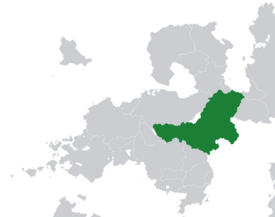Luepola: Difference between revisions
No edit summary |
No edit summary |
||
| Line 122: | Line 122: | ||
}} | }} | ||
'''Luepola''', officially the '''Republic of Luepola''' ([[Luepolan language|Luepolan]]: ''Respublika Ľupolska''), is a federal parliamentary republic located in [[eastern Patyria]]. It is divided into thirteen ''voblasts'' (states), two federal municipalities, and one disputed Special Administrative Zone. Luepola covers a total of 821,700 square kilometers, making it the second largest in Patyria after the [[Aitic Federation]], and has a population of 79,406,594, making it the third most populous nation in Patyria after the Aitic Federation and [[Vierzland]]. Luepola's capital is Prishek, and its largest city is Voitz. Other notable Luepolan cities include [[Rostva]], [[Pomorna]], [[Hrdovna]], [[Zvin]], [[Grast]], and [[Utrna]]. | '''Luepola''', officially the '''Republic of Luepola''' ([[Luepolan language|Luepolan]]: ''Respublika Ľupolska''), is a federal parliamentary republic located in [[eastern Patyria]]. It is divided into thirteen ''voblasts'' (states), two federal municipalities, and one disputed Special Administrative Zone. Luepola covers a total of 821,700 square kilometers, making it the second largest in Patyria after the [[Aitic Federation]], and has a population of 79,406,594, making it the third most populous nation in Patyria after the Aitic Federation and [[Vierzland]]. Luepola's capital is [[Prishek]], and its largest city is [[Voitz]]. Other notable Luepolan cities include [[Rostva]], [[Pomorna]], [[Hrdovna]], [[Zvin]], [[Grast]], and [[Utrna]]. | ||
Luepola is bordered to the north by [[Vyzinia]], [[Plosenia]], and the [[Gulf of St. Jan]]; to the east by [[Tanavia]], [[Vorochia]], and the [[Oriental Sea]]; to the south by [[Zacotia]] and [[Granzery]]; and to the west by [[Lairea]] and Vierzland. | Luepola is bordered to the north by [[Vyzinia]], [[Plosenia]], and the [[Gulf of St. Jan]]; to the east by [[Tanavia]], [[Vorochia]], and the [[Oriental Sea]]; to the south by [[Zacotia]] and [[Granzery]]; and to the west by [[Lairea]] and Vierzland. | ||
Revision as of 00:10, 17 July 2019
This article is incomplete because it is pending further input from participants, or it is a work-in-progress by one author. Please comment on this article's talk page to share your input, comments and questions. Note: To contribute to this article, you may need to seek help from the author(s) of this page. |
Republic of Luepola Respublika Ľupola | |
|---|---|
| Motto: "Po pravam ili silam" "By right or might" | |
| Anthem: Himna Volnosću Hymn to Willpower | |
Location of Luepola (dark green) and disputed Star Island (light green) | |
| Capital | Prishek |
| Largest city | Voitz |
| Official languages | Luepolan |
| Recognised regional languages | |
| Ethnic groups (2018) | Luepolan Molves 77% Non-Luepolan Molves 9% Njataris 5% Vierz 4% Caraqis 2% Oridians 2% Other 1% |
| Religion | Orthodoxy |
| Demonym(s) | Luepolan |
| Government | Federal semi-presidential republic |
• President | Savo Grigorević |
• Vice President | Radovan Kozić |
• Prime Minister | Martin Vlahac |
| Legislature | Luepolan Assembly Ľupolski Sbor |
| Sliet | |
| High Assembly of Luepola Veliki Sbor Ľupoloj | |
| Establishment | |
• Unification of Varadna and Strentland | August 4, 1329 |
• Declaration of the Kingdom of Luepola | July 10, 1390 |
| May 16, 1976 | |
• Current government internationally recognized | 1982-86 |
| Area | |
• | 821,700 km2 (317,300 sq mi) |
| Population | |
• 2019 census | 79,406,594 |
| GDP (PPP) | 2019 estimate |
• Total | $2,185,348,873,474 (2.1 trillion) |
• Per capita | $27,521 |
| GDP (nominal) | 2019 estimate |
• Total | $1,798,559,354,100 (1.8 trillion) |
• Per capita | $22,650 |
| Gini | 29.1 low |
| HDI | 0.845 very high |
| Currency | Luepolan Grivna (₴) (LG) |
| Time zone | UTC+2 |
| Date format | dd.mm.yyyy |
| Driving side | right |
| Calling code | +52 |
| Internet TLD | .lu |
Luepola, officially the Republic of Luepola (Luepolan: Respublika Ľupolska), is a federal parliamentary republic located in eastern Patyria. It is divided into thirteen voblasts (states), two federal municipalities, and one disputed Special Administrative Zone. Luepola covers a total of 821,700 square kilometers, making it the second largest in Patyria after the Aitic Federation, and has a population of 79,406,594, making it the third most populous nation in Patyria after the Aitic Federation and Vierzland. Luepola's capital is Prishek, and its largest city is Voitz. Other notable Luepolan cities include Rostva, Pomorna, Hrdovna, Zvin, Grast, and Utrna.
Luepola is bordered to the north by Vyzinia, Plosenia, and the Gulf of St. Jan; to the east by Tanavia, Vorochia, and the Oriental Sea; to the south by Zacotia and Granzery; and to the west by Lairea and Vierzland.
History
Prehistory
Pre-Unification (until 1329)
Varadna-Strentland (1329-1390)
The Kingdom of Luepola, then known as Strentland-Varadna, was established in 1329 by Genadi the Great. At the time, Genadi was the king of Strentland, and was married to Princess Vladislava I of the neighboring Kingdom of Varadna. In 1429, Queen Anna of Varadna died a sudden death. As the Varadian line of succession followed a system of Absolute primogeniture, the throne was passed to Anna. The coronation of Genadi's wife as the Queen of Varadna left Genadi the Younger, their firstborn son, as the heir to both thrones. Recognizing this development, Genadi and Vladislava began work consolidating their two kingdoms, in preparation for the merge; border controls were abolished and nobles from each country were encourage to marry those in the other. On August 4, 1329, Genadi and Vladislava jointly declared the establishment of Varadna-Strentland, and Genadi proclaimed himself 'Genadi the Great'.
Genadi's death in 1355 saw the passing of the throne to his son, Genadi the Younger. His rule aimed to complete the unification of Varadna-Strentland, consolidating the houses of Modrić and Kitarović into a single house. His efforts, however, were largely unsuccessful. After attempting to pressure nobles into marrying into eachother's houses, Genadi the Younger was assassinated in 1363. Genadi the Younger's death started a succession crisis - as the houses of Modrić and Kitarović had not yet unified, they each followed different orders of succession, leading to disagreement as to who should succeed Genadi the Younger on the throne. The House of Kitarović, from which Vladislava I hailed, followed a system of absolute primogeniture, and believed that Genadi's sister, Princess Cvieta, should inherit the throne. The House of Modrić, on the other hand, followed male-preference primogeniture, and believed that Genadi's brother, Prince Nikolas, should succeed him, despite him being younger than Cvieta.
This disagreement quickly erupted into a full-blown civil conflict, with the nobles of the House of Modrić and the House of Kitarović, and their servants and supporters, battling one another. This has since become known as the War of Luepolan Succession. Though the House of Modrić initially had the upper hand in the war due to its support base spanning the former territory of the larger Kingdom of Strentland, the relatively progressive ideals of the House of Kitarović appealed to the broader populace of Varadna-Strentland, enabling Princess Cvieta's support base to expand, an advantage that transformed itself into numerous victories. In the Battle of Širotsk in 1368, Cvieta's army killed Nikolas and inflicted massive casualties on his army, forcing the pro-Modrić army to surrender. The peace agreement acknowledged Cvieta as the rightful heir the throne of Varadna-Strentland, and shortly after the cessation of hostilities she was coronated as Cvieta I.
During the war, Cvieta married Paveu Brnić, the highest ranking officer of the pro-Kitarović army who was not a member of the house, and in 1366 gave birth to Prince Luka Modrić, who would become the next king of Varadna-Strentland.
In an act of reconciliation to her former foes, she issued the Edict of Mlaževo in 1369, which exchanged amnesty to the nobles of the House of Modrić who were put on trial in return for the House of Modrić agreeing to adopt a system of absolute primogeniture. Having forced the House of Modrić to adopt an order of succession that legitimized herself as dynast, Cvieta declined to reinstate herself into the house of Kitarović, which left the Modrić dynasty as the official ruling dynasty of Varadna-Strentland.
Shortly after the end of the War of Luepolan Succession, Varadna-Strentland faced war from its neighbors Plosenia and Zacotia, whose leaders both feared the potential powerhouse in the east that the new union could become, and who sought to take advantage of Varadna-Strentland's weakened post-war state to strike it down and gain land and influence. In 1374, the Zacotian army marched into Strentland and laid siege to the port of Rostva, beginning the Containment War. The Containment War quickly bogged down into a stalemate on both fronts.
Cvieta I died of natural causes in 1382, leaving 16-year-old Luka as the wartime monarch of Varadna-Strentland. Luka's first edict as the new King of Varadna-Strentland temporarily restored his powers as commander of the army to his father, Paveu Brnić, who previously had been delegated the same powers under Cvieta. Mistaking the transition of power as a potential period of confusion and disorder in Varadna-Strentland, Zacotia and Plosenia both launched large-scale offensives against Varadna-Strentland, which were quickly routed by the unexpectedly strong and organized defense.
Luka's next significant action was to appeal to the neighboring Kingdom of Vyzinia. With the aid of older, more experienced diplomats, Luka successfully encouraged Joseph IV of Vyzinia to declare war on Plosenia in 1386, promising them much of Plosenia's land and the wealth within. The deplpyment of the Vyzinian army to Plosenia threw Plosenia into disarray, enabling the army of Varadna-Strentland to push into Plosenia. The northern front culminated in the Siege of Pomorna in 1387, which forced the surrender of Plosenia to Vyzinia and Varadna-Strentland. Recognizing the soon-to-be dire situation for their army, Zacotia surrendered to Varadna-Strentland in 1388. In the various post-war peace agreements, Varadna-Strentland annexed much of northern Zacotia, and partitioned Plosenia between itself and Vyzinia, in the process gaining coastline on the Gulf of St. Jan. Some of the established borders remain to this day as Luepola's border with Plosenia and Zacotia.
Two years after the surrender of Zacotia, in 1390, Luka declared that the Kingdom of Varadna-Strentland would be renamed to the Kingdom of Luepola, after the traditional name of the common language spoken in the majority of Varadna-Strentland's new territory. Though Luepola's modern name was first used here, the kingdom was often referred to as Strentland among the other nations of Patyria until the 1800s.
Kingdom of Luepola (1390-1752)
First Republic of Luepola (1752-1894)
People's Republic of Luepola (1894-1947)
Vierz Occupation of Luepola (1947-1985)
Second Republic of Luepola (1985-Present)
Geography
Luepola is a modestly-sized nation, with 1,274,490 square kilometers of territory. The nation has a temperate climate, and ranges in elevation from sea level along the coast to mountains over 2,500 meters high in the inland western regions.
Demographics
| Largest cities of Luepola (2019 census) | |||||||||
|---|---|---|---|---|---|---|---|---|---|
| City | Population | State | City | Population | State | ||||
| 1 | Voitz | 2,364,964 | Občina Vojc | 11 | Bráznica | 595,788 | Aneska | ||
| 2 | Rostva | 1,512,376 | Jutska | 12 | Elenevo | 581,393 | Jutska | ||
| 3 | Prishek | 948,083 | Hautbecirk | 13 | Čakajec | 560,848 | Bružka | ||
| 4 | Zvin | 713,555 | Varadna | 14 | Aneska | 557,854 | Aneska | ||
| 5 | Grast | 704,721 | Trnava | 15 | Voľana | 547,967 | Varadna | ||
| 6 | Kořevac | 687,397 | Trnava | 16 | Nediňe | 539,901 | Bosunija | ||
| 7 | Bosaňe | 664,919 | Dvolăn | 17 | Mlaževo | 500,608 | Varadna | ||
| 8 | Hrdovna | 655,083 | Sevierna | 18 | Đalan | 488,226 | Nimorăn | ||
| 9 | Utrna | 644,323 | Bosunija | 19 | Judusa | 472,475 | Bosunija | ||
| 10 | Pomorna | 638,575 | Jutska | 20 | Obránse | 470,273 | Cărnipoře | ||
Ethnic Groups
Religion
Christianity is the dominant religion in Luepola, encompassing 77% of the population. Of this, 14% professed to be Catholics, whereas the other 86% professed to be Orthodox.
Approximately 15% of Luepolans claim to be Atheist or Agnostic, or otherwise irreligious.
About 2% of Luepolans profess Islam as their religion. Of these, 60% claim to be Ibadi Muslims, and 30% claimed to be Sunni Muslims. Sufis and Shi'ites encompass the remaining 10%.
5% of Luepolans claim to be followers of another religion. Noteworthy religions in this category include Judaism, Hinduism, and Shinto.
Government

The Luepolan government consists of three branches: the Luepolan Assembly, which is the legislative body of the government; the Executive branch, which is composed of the President, Vice President, cabinet, and most government agencies; and the Luepolan National Court, which is the highest judiciary body in the nation.
The Luepolan Assembly (Luepolan: Ľupolski Sbor) is a bicameral legislature which consists of two houses. The Sliet consists of four representatives from each state, who are voted into office by the representatives of the Lower House. The Lower House, officially known as the High Assembly of Luepola (Luepolan: Veliki Sbor Ľupoloj) consists of over two hundred representatives that represent the states based on population, and whose representatives are voted into office through public elections. Representatives in both houses serve four-year terms and are restricted to three-term limits. The legislative body has the collective power to propose and pass legislature, to permit or deny peace treaties, and to declare war on another nation. The senate also has the power to override a presidential veto on a piece of legislature, provided a 2/3 majority is reached. If a 3/4 majority is present in the original vote, the vote pre-emptively overrides a possible veto from the president. The senate also has the power to decide if a president is to be impeached, and to approve of a presidential nomination to the High Court. The leader of the Sliet's majority, whether a coalition or single party, is appointed as the Prime Minister of Luepola.
The Executive Branch consists of the President, who is elected by popular vote in a runoff election. The President is the Head of State of the nation. The President appoints personal advisors to his cabinet, who function as the heads of the various government agencies. The President is the ceremonial Commander-in-Chief of the Armed Forces. The President is also responsible for signing bills passed in the Assembly, or vetoing them. The President also appoints judges to the High Court, though they must be approved by the Assembly. The President can serve up to three four-year terms, though all presidents elected since 1985 have served for two terms at most.
The High Court is the supreme judiciary body of the nation, and handles cases that have been appealed past all regional courts. The High Court also determines whether a bill is permissible according to the Luepolan Constitution, and is in charge of handling impeachment cases. Judges are appointed by the President and approved by the Assembly, and may serve for a maximum of thirty years, though these terms may be cut short by voluntary retirement or death. A judge cannot be legally removed from his position except by his own retirement or by term expiration.
Savo Grigorević, the incumbent president of Luepola.
Luepolan Armed Forces
The Luepolan Armed Forces are composed of five branches: the Ground Forces (Luepolan: Vojsko Zemľe), the Air Force (Luepolan: Luftsila), the Navy (Luepolan: Flot), the Expeditionary Force (Luepolan: Vojsko Otpravke), and the National Security Force (Luepolan: Sila dľa Bezopasnosće Strane). Each branch is commanded by a Marshal. The entire armed forces are commanded by the Armed Forces' Grand Marshal. In addition, Luepola has de facto control of various paramilitary groups, the most notable of which is the Overseas Forces (Luepolan: Vojsko Přémorsko); an armed group that consists of non-Luepolans fighting for Luepolan interests abroad.
The Land Force is statistically the largest branch of the Luepolan Armed Forces, and considered to be the most potent. The ground forces cover all aspects of land-based combat, from urban fighting, to artillery, armored warfare, and mechanized maneuvers. The ground forces also operate helicopters and small numbers of attack aircraft.
The Navy is the second-largest branch of the Luepolan military. The Navy operates various surface vessels and submarines, as well as helicopters and ground-based anti-ship missiles. It is responsible for carrying military equipment and soldiers long-distances, as well as engaging enemy fleets, defending and patrolling Luepolan waters, and supporting ground forces wherever possible. The Navy also operates three ballistic-missile submarines, which form the first of Luepola's two nuclear-armed strike forces.
The Air Force is the third largest branch. It operates all types of fixed-wing aircraft, as well as ground-based air defense systems and small numbers of helicopters. The Air Force is also responsible for any Luepolan military operations conducted in Low-Earth Orbit; however, no military operations have taken place in space in Luepolan history. Furthermore, the bombers of the Air Force form the second nuclear-armed strike force, and the larger of the two.
The SBS is the fourth-largest branch of the military, and serves as the home guard for Luepola. It also handles other domestic issues, such as humanitarian and counter-terrorism operations, and defending the nation in the event of an invasion, including organizing armed paramilitary and partisan groups.
The Expeditionary Force is the smallest branch of the military, though still respectfully large. The Expeditionary Force is a combined-arms branch, operating fixed-wing aircraft, helicopters, maritime craft, and armored vehicles, and is responsible for cyber warfare operations. Furthermore, Special Command Group (Luepolan: Befielsgruppa Pekuljarna), the command organization for Luepolan Special Forces groups, falls under the jurisdiction of the Expeditionary Force. It is considered the most elite of the five branches.









